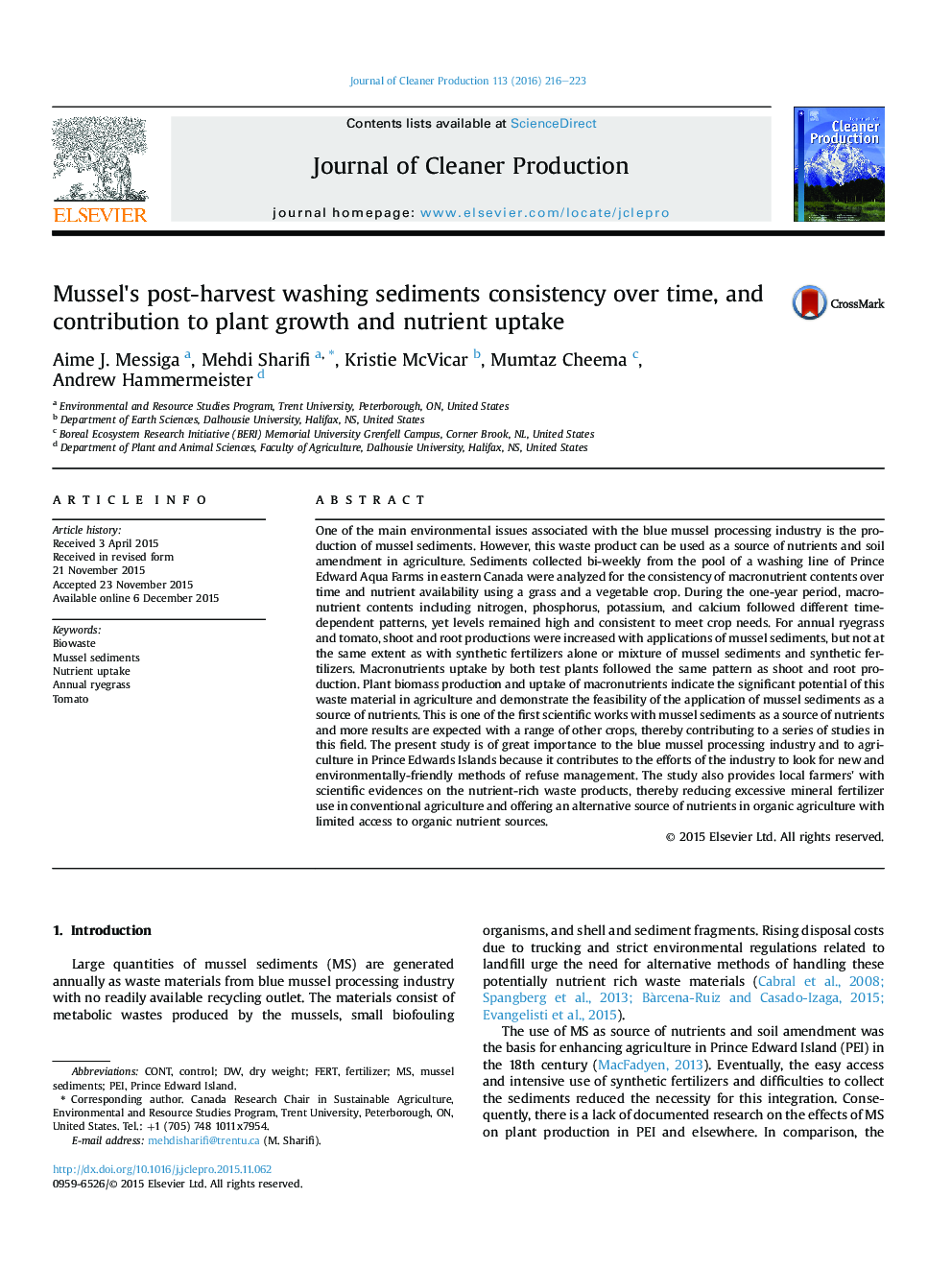| کد مقاله | کد نشریه | سال انتشار | مقاله انگلیسی | نسخه تمام متن |
|---|---|---|---|---|
| 8102849 | 1522136 | 2016 | 8 صفحه PDF | دانلود رایگان |
عنوان انگلیسی مقاله ISI
Mussel's post-harvest washing sediments consistency over time, and contribution to plant growth and nutrient uptake
ترجمه فارسی عنوان
رسوبات رسوب گذار پس از برداشت موسل در طول زمان، و سهم در رشد گیاه و جذب مواد مغذی
دانلود مقاله + سفارش ترجمه
دانلود مقاله ISI انگلیسی
رایگان برای ایرانیان
ترجمه چکیده
یکی از مهمترین مسائل زیست محیطی مرتبط با صنعت پردازش آبی مسیله تولید رسوبات گندم است. با این حال، این محصول زباله می تواند به عنوان منبع مواد مغذی و اصلاح خاک در کشاورزی استفاده شود. رسوبات جمع آوری شده دو هفته ای از استخر یک خط شستشو پرندگان ادوارد آکو مزارع در شرق کانادا برای همگنی مواد مغذی مواد در طول زمان و دسترسی به مواد مغذی با استفاده از یک چمن و یک محصول سبزیجات تجزیه و تحلیل شد. در طی یک سال، محتویات مغذی شامل نیتروژن، فسفر، پتاسیم و کلسیم به دنبال الگوهای مختلف وابسته به زمان بود، در حالیکه سطوح باقیمانده بالا و سازگار با نیازهای محصول بود. برای سالیانه ریشه گیاهان و گوجه فرنگی، ساقه و ریشه تولید با استفاده از رسوبات گوجهفرنگی افزایش یافته است، اما نه به اندازه کودهای مصنوعی به تنهایی و یا مخلوط شدن رسوبات گندم و کودهای مصنوعی. جذب مواد مغذی هر دو گیاهان آزمایش شده با همان الگوی شبیه سازی شده و تولید ریشه ها انجام شد. تولید زیست توده گیاهی و جذب مواد مغذی نشان دهنده توان بالقوه این مواد زائد در کشاورزی است و نشان دهنده امکان استفاده از رسوبات گوشتی به عنوان منبع مواد مغذی است. این یکی از اولین آثار علمی با رسوبات گوسفندی به عنوان منبع مواد مغذی است و نتایج حاصل از آن با طیف وسیعی از محصولات دیگر به دست می آید و در نتیجه به مجموعه ای از مطالعات در این زمینه کمک می کند. مطالعه حاضر اهمیت زیادی برای صنعت پردازش آبی مسیل و کشاورزی در جزایر پرنس ادواردز دارد زیرا به تلاش های صنعت کمک می کند تا به دنبال روش های جدید مدیریت زیست محیطی و محیط زیست باشند. این تحقیق همچنین نشان می دهد کشاورزان محلی با شواهد علمی در مورد مواد زائد غنی از مواد مغذی، در نتیجه کاهش مصرف کود معدنی در کشاورزی معمولی و ارائه منبع جایگزین مواد مغذی در کشاورزی ارگانیک با دسترسی محدود به منابع مواد مغذی ارگانیک.
موضوعات مرتبط
مهندسی و علوم پایه
مهندسی انرژی
انرژی های تجدید پذیر، توسعه پایدار و محیط زیست
چکیده انگلیسی
One of the main environmental issues associated with the blue mussel processing industry is the production of mussel sediments. However, this waste product can be used as a source of nutrients and soil amendment in agriculture. Sediments collected bi-weekly from the pool of a washing line of Prince Edward Aqua Farms in eastern Canada were analyzed for the consistency of macronutrient contents over time and nutrient availability using a grass and a vegetable crop. During the one-year period, macronutrient contents including nitrogen, phosphorus, potassium, and calcium followed different time-dependent patterns, yet levels remained high and consistent to meet crop needs. For annual ryegrass and tomato, shoot and root productions were increased with applications of mussel sediments, but not at the same extent as with synthetic fertilizers alone or mixture of mussel sediments and synthetic fertilizers. Macronutrients uptake by both test plants followed the same pattern as shoot and root production. Plant biomass production and uptake of macronutrients indicate the significant potential of this waste material in agriculture and demonstrate the feasibility of the application of mussel sediments as a source of nutrients. This is one of the first scientific works with mussel sediments as a source of nutrients and more results are expected with a range of other crops, thereby contributing to a series of studies in this field. The present study is of great importance to the blue mussel processing industry and to agriculture in Prince Edwards Islands because it contributes to the efforts of the industry to look for new and environmentally-friendly methods of refuse management. The study also provides local farmers' with scientific evidences on the nutrient-rich waste products, thereby reducing excessive mineral fertilizer use in conventional agriculture and offering an alternative source of nutrients in organic agriculture with limited access to organic nutrient sources.
ناشر
Database: Elsevier - ScienceDirect (ساینس دایرکت)
Journal: Journal of Cleaner Production - Volume 113, 1 February 2016, Pages 216-223
Journal: Journal of Cleaner Production - Volume 113, 1 February 2016, Pages 216-223
نویسندگان
Aime J. Messiga, Mehdi Sharifi, Kristie McVicar, Mumtaz Cheema, Andrew Hammermeister,
